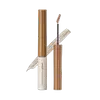What's inside
What's inside
 Key Ingredients
Key Ingredients

 Benefits
Benefits

No benefits
 Concerns
Concerns

 Ingredients Side-by-side
Ingredients Side-by-side

Isododecane
EmollientTalc
AbrasiveTrimethylsiloxysilicate
EmollientSynthetic Wax
AbrasiveCI 77891
Cosmetic ColorantCI 77499
Cosmetic ColorantDisteardimonium Hectorite
StabilisingCI 77492
Cosmetic ColorantHydrogenated Polyisobutene
EmollientCI 77491
Cosmetic ColorantPropylene Carbonate
SolventDextrin Palmitate/Ethylhexanoate
EmulsifyingPolypropylsilsesquioxane
Aluminum Myristate
Emulsion StabilisingTriethoxycaprylylsilane
Aluminum Hydroxide
EmollientEthylhexylglycerin
Skin ConditioningWater
Skin ConditioningIsododecane, Talc, Trimethylsiloxysilicate, Synthetic Wax, CI 77891, CI 77499, Disteardimonium Hectorite, CI 77492, Hydrogenated Polyisobutene, CI 77491, Propylene Carbonate, Dextrin Palmitate/Ethylhexanoate, Polypropylsilsesquioxane, Aluminum Myristate, Triethoxycaprylylsilane, Aluminum Hydroxide, Ethylhexylglycerin, Water
Isododecane
EmollientAluminum Starch Octenylsuccinate
AbsorbentTrimethylsiloxysilicate
EmollientDimethicone
EmollientDisteardimonium Hectorite
StabilisingPropylene Carbonate
SolventPentylene Glycol
Skin ConditioningC8-9 Isoalkane
SolventSilica Silylate
EmollientCaprylyl Glycol
EmollientIsopropyl Titanium Triisostearate
EmollientAlumina
AbrasiveCI 77491
Cosmetic ColorantCI 77492
Cosmetic ColorantCI 77499
Cosmetic ColorantCI 77891
Cosmetic ColorantMica
Cosmetic ColorantCI 77742
Cosmetic ColorantCI 77510
Cosmetic ColorantIsododecane, Aluminum Starch Octenylsuccinate, Trimethylsiloxysilicate, Dimethicone, Disteardimonium Hectorite, Propylene Carbonate, Pentylene Glycol, C8-9 Isoalkane, Silica Silylate, Caprylyl Glycol, Isopropyl Titanium Triisostearate, Alumina, CI 77491, CI 77492, CI 77499, CI 77891, Mica, CI 77742, CI 77510
Ingredients Explained
These ingredients are found in both products.
Ingredients higher up in an ingredient list are typically present in a larger amount.
Ci 77491 is also hydrated iron III oxide. It's sole purpose is to give a red/pink hue to products.
Iron III oxides are classified as inorganic chemicals for coloring.
Synthetically created Ci 77491 is considered safer than those naturally found. This is because the synthetically created version may contain less impurities. Iron oxides are generally non-toxic and non-allergenic.
Learn more about CI 77491Ci 77492 is also hydrated iron III oxide. It's sole purpose is to give a yellow hue to products.
Iron III oxides are classified as inorganic chemicals for coloring.
Synthetically created Ci 77492 is considered safer than those naturally found. This is because the synthetically created version may contain less impurities. Iron oxides are generally non-toxic and non-allergenic.
Learn more about CI 77492Ci 77499 is also hydrated iron III oxide. It is created from mixing red and black iron oxides. This helps give shades of darkness to a product.
Iron III oxides are classified as inorganic chemicals for coloring.
Ci 77891 is a white pigment from Titanium dioxide. It is naturally found in minerals such as rutile and ilmenite.
It's main function is to add a white color to cosmetics. It can also be mixed with other colors to create different shades.
Ci 77891 is commonly found in sunscreens due to its ability to block UV rays.
Learn more about CI 77891Disteardimonium Hectorite comes from the clay mineral named hectorite. It is used to add thickness to a product.
It can also help stabilize a product by helping to disperse other ingredients.
Hectorite is a rare, white clay mineral.
Learn more about Disteardimonium HectoriteIsododecane is a fragrance, emollient, and solvent.
As an emollient, it helps your skin stay soft and hydrated. Emollients help trap moisture into your skin.
Isododecane's role as a solvent makes it a great texture enhancer. It spreads smoothly on skin and does not leave a sticky feeling behind. Isododecane also helps prevent color transfer in makeup products.
Isododecane is not absorbed into skin.
Learn more about IsododecaneThis ingredient is a solvent. It helps dissolve active ingredients and alter the texture of products.
Propylene Carbonate is commonly used in makeup and with clay, such as montmorillonite or bentonite.
Studies show this ingredient to be safe for cosmetics. When it is undiluted, it can cause skin irritation. (It is always diluted in skincare and makeup). This ingredient is water-soluble.
Propylene Carbonate is created from propylene glycol and carbonic acid.
Learn more about Propylene CarbonateThis silicone is an emollient. Emollients create a thin film on the skin to prevent moisture from escaping.
It is not soluble in water and helps increase water-resistance in products.
According to a manufacturer, it can blend seamlessly with silicone oils, such as Cyclopentasiloxane.
Learn more about Trimethylsiloxysilicate